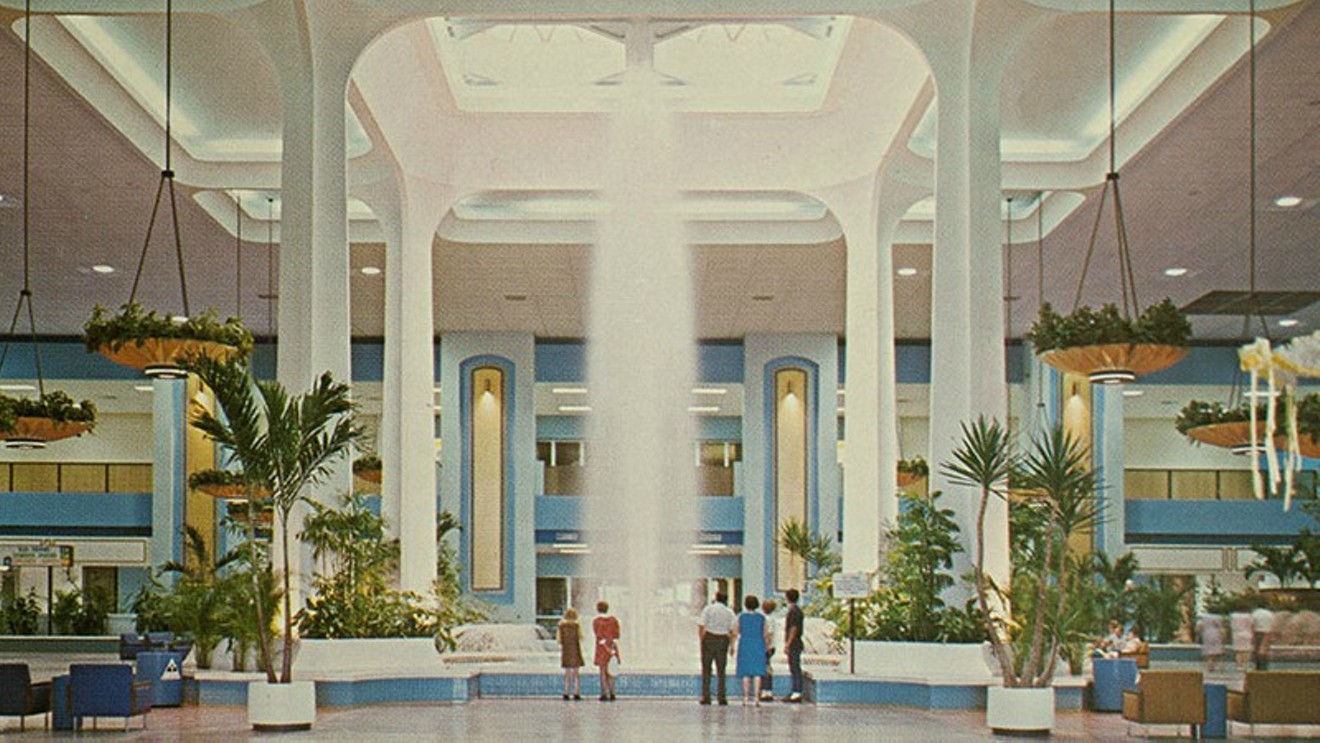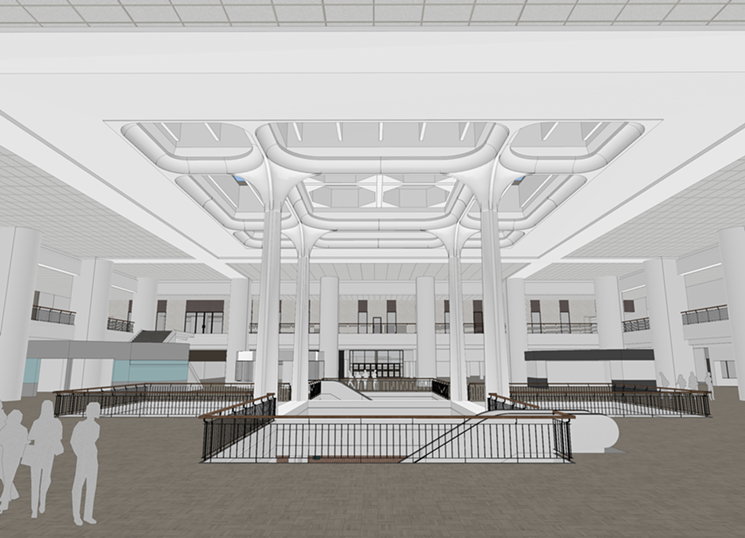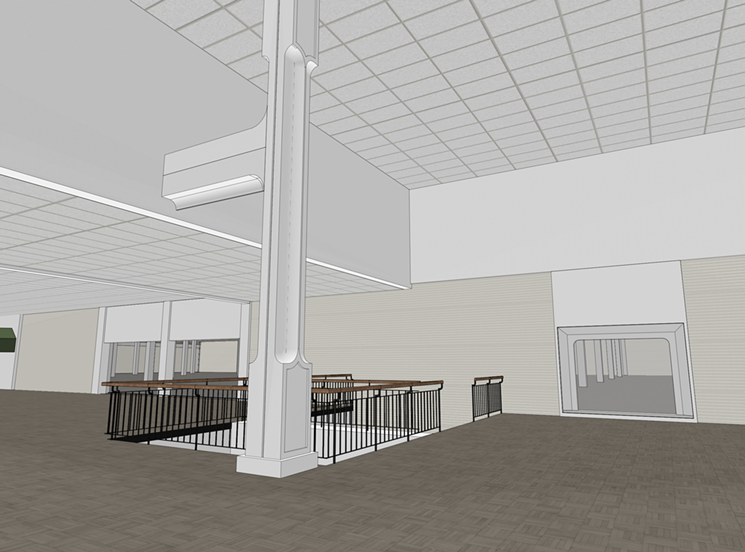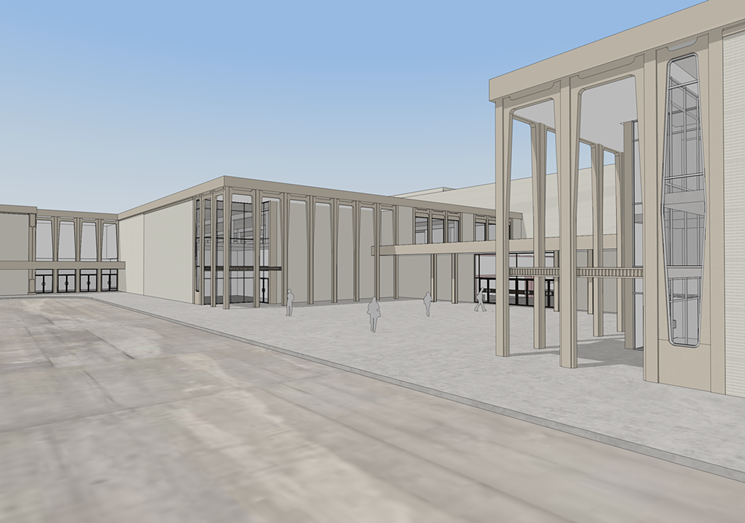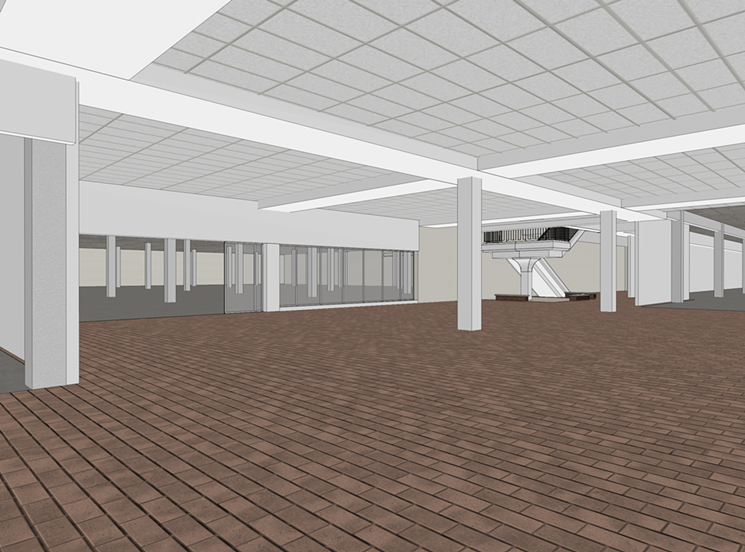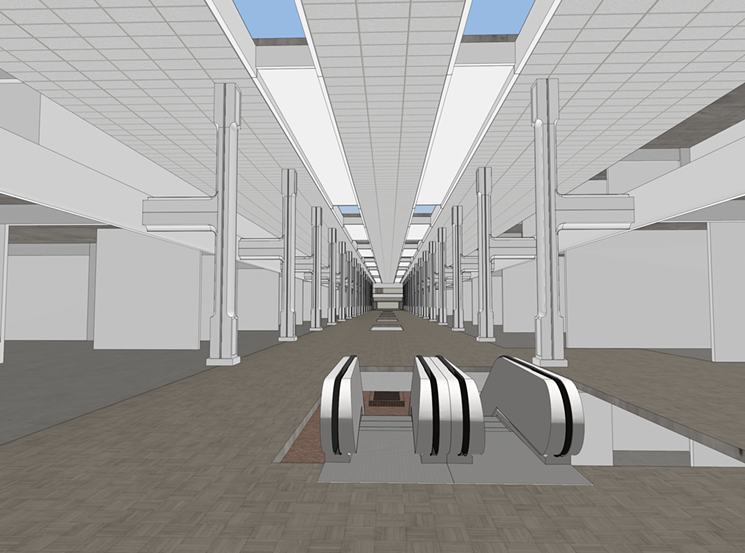A half-century ago this month, in March 1968, Cinderella City opened in Englewood, and it was much more than a mere mall. An ad from the early days maintained that "Once Upon a Time...Is Now at Cinderella City," where "Your Shopping Dreams Come True," and for a generation of Denverites, as well as folks who traveled from all over the region to behold its marvels in person, these pitch lines were on the money.
Those glory days ended with the edifice's late-1990s demolition — but they're set to make a virtual return. Denver designer Josh Goldstein is currently working on what he calls a "fully-detailed digital recreation of Cinderella City Mall for a Virtual Reality experience" he hopes to complete by the end of the attraction's fiftieth-anniversary year.
The five sections, or malls, within Cinderella City were designated by color (blue, rose, shamrock and gold), with the exception of an area dubbed Cinder Alley. The Goldstein-created preliminary images seen throughout this post offer a sneak preview of the project as a whole.
"I saw Cinderella City getting demolished as a seven-year-old, and it sparked my interest in architecture," notes Goldstein, corresponding via email. "I learned how to research the mall in the early days of the Internet and ended up finding a trove of photos from the Englewood website."
Shortly thereafter, he goes on, "I started a collection of documents on the place. Something about seeing that mall in a partially demolished state really stuck with me, and the photos of it in its heyday and the story of its accelerated demise fascinated me, too."
In 2006, Goldstein notes, "I landed a job as a high school intern with Alberta Development Partners working as an 'assistant project manager' on the Streets at SouthGlenn project in Centennial. I learned all about what happens when a large retail facility (in this case, Southglenn Mall) was abandoned, prepped for demolition, then redeveloped into a new place for the community."
Along the way, Goldstein "was able to learn firsthand the various phases of the process, from environmental remediation to the prepping of the site for the new construction. After the mall was demolished, I joined the design team and used my fledgling 3D modeling skills and learned Adobe products to help the design team with design deliverables for the project."
Goldstein "got a Master of Architecture degree from Kansas State University in 2013 and returned to Colorado to join a design firm that Alberta had worked with on Southglenn and other projects. I've always had my eye on a career in technology and was getting involved in beta programs for modeling software we used and also leading a design technology committee at the firm when I was hired by Autodesk in 2015 to work on the next generation of 3D modeling tools for architects like myself."
Today, Goldstein continues, "I find myself coming full circle, by modeling this massive building partially for my own understanding of the place that has fascinated me for twenty years, but also as a testing ground for our software, FormIt. I've found a series of bugs and performance issues that were subsequently fixed for customers, thanks to this model."
He describes the Cinderella City VR project like so:
• "Develop the 1980s/90s version of the mall first, since I have the most information on that (I've found so many more photographs of it abandoned than any other era).
• "Use the 1980s model to backport a 1960s version of the mall that represents what it looked like and how it was laid out prior to the major renovation in the early 1980s — and to make a very 1960s experience!
• "Then develop an alternate reality model that explores what could have been if the structure was mostly saved and adaptively reused into a new mixed-use development. The structure was entirely concrete, so it would have been feasible to strip it down and keep larger portions, but cut it up in interesting ways, adding new spaces but celebrating some of the old spaces. The parking garage could have been turned into a giant park, with some parts of the structure kept for shade, providing an interesting juxtaposition of concrete and vegetation."
This last concept "is really exciting to me as a former architect, because I think we need to have a conversation on how often we demolish buildings and how disposable our landscape has become. I previously worked on some adaptive reuse concepts at the firm, including for some shopping centers, and I think this could have been feasible in 1998, even though the mall is long gone now."
The software Goldstein is using "has a fairly direct integration with VR systems. So my ultimate plan is to plug all three versions of the model (1960s, 1980s, and alternate reality) into a VR headset and let people walk around the property and quickly swap between the 1960s, 1980s and alternate versions of the building, while maintaining their position in space. I've already walked around the current state of the 1980s version of the mall, and it's simply amazing to experience it in scale. Also, I'd like to develop a way to allow people who remember the mall to place 'memories' along its corridors in virtual reality — maybe recordings of them sharing a memory from this particular spot, or about this store, etc. That would be a pretty sweet interactive exhibit."
The early images shared here speak to the level of detail Goldstein seeks to achieve.
"I started by analyzing construction documents I got from the Englewood library to determine the column and structural grid system, and built that up first (so all the beams, joists, columns are actually underneath what you see and provide the underpinnings of an accurate model)," he reveals. "This allowed me to interpret a bunch of other dimensions and then layer up the store walls, ceilings, soffits and other decorative details over the structure for a very accurate representation of the entire shopping center."
Getting all of this right isn't easy.
"This is a long process, as you can imagine," he concedes. "But our software has enabled me to get pretty far since starting in August thanks to some of its 3D modeling capabilities. I've finally gotten all five malls (Rose/Shamrock, Gold/Cinder Alley, Blue) at least to the level of having store-demising walls, hallway layouts, basic materials, etc., and am adding storefronts, stairs, railings and ceiling/floor details to most of the areas. I want to get as far as I can on the 1980s version so I can start with a lot of content for the 1960s version."
The goal for Goldstein is to finish up this year, so that people who remember Cinderella City, and those who don't, can experience it virtually.
For more information about Goldstein, visit www.jdeangoldstein.com. If you have any vintage photos of Cinderella City that he might be able to use to make the project even better, email him at [email protected]. And view the treasures he's already received on the Cinderella City Project Instagram page.
[
{
"name": "Air - MediumRectangle - Inline Content - Mobile Display Size",
"component": "12017618",
"insertPoint": "2",
"requiredCountToDisplay": "2"
},{
"name": "Editor Picks",
"component": "17242653",
"insertPoint": "4",
"requiredCountToDisplay": "1"
},{
"name": "Inline Links",
"component": "18838239",
"insertPoint": "8th",
"startingPoint": 8,
"requiredCountToDisplay": "7",
"maxInsertions": 25
},{
"name": "Air - MediumRectangle - Combo - Inline Content",
"component": "17261320",
"insertPoint": "8th",
"startingPoint": 8,
"requiredCountToDisplay": "7",
"maxInsertions": 25
},{
"name": "Inline Links",
"component": "18838239",
"insertPoint": "8th",
"startingPoint": 12,
"requiredCountToDisplay": "11",
"maxInsertions": 25
},{
"name": "Air - Leaderboard Tower - Combo - Inline Content",
"component": "17261321",
"insertPoint": "8th",
"startingPoint": 12,
"requiredCountToDisplay": "11",
"maxInsertions": 25
}
]

